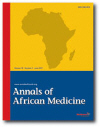
|
Annals of African Medicine
Annals of African Medicine Society
ISSN: 1596-3519
Vol. 6, No. 1, 2007, pp. 12-16
|
 Bioline Code: am07003
Bioline Code: am07003
Full paper language: English
Document type: Research Article
Document available free of charge
|
|
|
Annals of African Medicine, Vol. 6, No. 1, 2007, pp. 12-16
| fr |
Adesiyun, A. G. & Eseigbe, E.
Résumé
Introduction/Objectif:
Décider des complications maternales et résultat foetal du gestation triplée.
Méthodes: Etude rétrospective de grossess femmes avec gestation triplée traitées la 10 ans.
Résultats:
Quatorze femmes traitées avec gestation triplée, parmis lesquelles 10, soit 71,4% ont été
inscrites pour des soins anténataux et quatre soit 28,6% ne s'étaient pas inscrites. L'âge moyen des
femmes étaient 31,3 ans. Tranche d'âge était entre vingt sept et trente neuf ans. Moyen d'âge
gestationnaire pendant diagnostic pour des femmes inscrites était 18,6 semaines. Entre le quatorze
patientes, dix (71,4%) avaient eu la conception spontanée, trois soit 21,4% ont suivi déclenchement
ovulaire et une soit 7,2% est attribuable à la fertilisation invitro et transfert d'embryon. Deux soit 14,3%
patients avaient eu un cerclage cervical à cause de leur dossier obstétrique du passé et évaluation de
l'utérus. Six (42,9%) patients avaient eu accouchement préterme. Age moyen gestational pendant
accouchement était 33,4 semaines. Parmi les trieze accouchements, neuf soit 69,2% avaient eu la
césarienne et quatre soit 30,48% ont accouché par vaginam. Un total de trente neuf bébés ont été
accouchés, trente quatre soit 87,2% bébés suvivent et cinq soit 12,8% morts. Mortalité périnatale était
11,9% et le taux de « take home » bébé était 81%.
Conclusion:
Des soins anténataux avec initiation des soins prénataux spécialisés et accouchement bien
organisé dans la gestation triplée améloire le résultat fetal.
Mots Clés
Gestation triplée, résultat, prise en charge
|
| |
| en |
Triplet Gestation: Clinical Outcome of 14 Cases
Adesiyun, A. G. & Eseigbe, E.
Abstract
Background/Objective:
To determine maternal complications and fetal outcome of triplet gestations.
Method:
Retrospective study of pregnant women with triplet gestation managed in 10 years.
Results:
Fourteen women were managed with triplet gestation, of these, (71.4%) were booked for
antenatal care and four (28.6%) were unbooked. The mean age of the women was 31.3 years. The age
range was between twenty seven years and thirty nine years. The mean gestational age at diagnosis for
the booked women was 18.6 weeks. Of the fourteen patients, ten (71.4%) had spontaneous conception,
three (21.4%) followed ovulation induction and one (7.2%) resulted from invitro fertilization and embryo
transfer. Two (14.3%) patients had cervical cerclage based on their past obstetric history and assessment
of the cervix. Six (42.9%) patients were hospitalized and treated for preeclampsia 3 patients, spontaneous
abortion 1 patient and cervical incompetence 2 patients. Eleven (78.6%) patients had preterm birth. The
mean gestational age at delivery was 33.4 weeks. Of the thirteen deliveries, nine (69.2%) had caesarean
section and four (30.8%) delivered per vaginam. A total of thirty nine babies were delivered, thirty four
(87.2%) babies survived and five (12.8%) died. Perinatal mortality was 11.9% and the "take home" baby
rate was 81%.
Conclusion:
Antenatal care with initiation of specialized prenatal care and planned delivery in triplet
gestation improves fetal outcome.
Keywords
Triplet gestation, outcome, management
|
| |
© Copyright 2007 - Annals of African Medicine
Alternative site location: http://www.annalsafrmed.org
|
|
